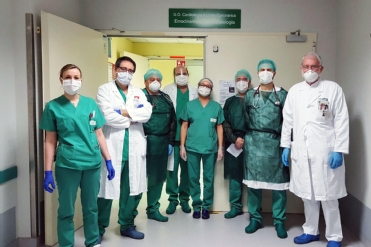By Drs. Maurizio Landolina, Erika Taravelli and Valentina De Regibus
Cardiology Department, Crema Hospital
 We are a group of cardiologists who work at the Hospital of Crema. Crema is a small, old town near Milan, which became a backdrop for the film “Call Me by Your Name”. It is less than 25 kilometres away from the Italian epicentre of the COVID-19 infection.
We are a group of cardiologists who work at the Hospital of Crema. Crema is a small, old town near Milan, which became a backdrop for the film “Call Me by Your Name”. It is less than 25 kilometres away from the Italian epicentre of the COVID-19 infection.
We have been one of the first hospitals to face this emergency and COVID-19 patients have swamped our Hospital. Since the beginning of this emergency, we are facing an exponential growth of hospitalised people with COVID-19. Now we can count around 100 hospitalized patients and we have around 60-80 new COVID-19 patients per day coming to the emergency. We are exhausted, but we don’t give up. Lombardy (our region) has a public health service that is considered the best in Italy, and the Italian health service is widely considered one of the best in Europe.
At the beginning, there was a huge debate about the way we test for the new coronavirus and the management of these patients. We were afraid of becoming infected, but day-by-day in our practice we are learning how to “recognise” suspected patients, how to read their CT scan, the therapy for the “easy” ones (the severe ones are managed by pulmonologists and anaesthesiologists) and, maybe even more important, how to protect ourselves. Several protocols prepared by our hospital direction help us in all these parts or at least try to help!
In our hospital an outdoor triage tent has been built so that once people arrive, COVID-19 suspected patients and non-COVID-19 patients travel different paths. Symptomatic patients waiting for the result of the upper respiratory tract tests are hospitalised in the former day-surgery and ortho wards and in part of the ER ward of course, in single (when possible) rooms. Confirmed COVID-19 patients are then moved to different wards depending on symptoms and need of care: patients requiring mechanical ventilation are in ICU and in some of the former operating rooms, transformed in ICU. Patients requiring high-flow oxygen non-invasive ventilation are in CCU, pneumology and otolaryngology wards, while stable patients are in surgery and medicine wards.
As you can see, the hospital has been transformed! Every non-urgent activity, including surgery and cardiac procedures, are suspended, not only here in Crema but in the whole Lombardy region, because we couldn't cope with the normal day routine plus this emergency. In our hospital only cardiology, part of neurology and part of oncology are COVID19-free wards. The STEMI network has been modified throughout Lombardy to provide the best therapy to both cardiac and COVID-19 patients: the ambulances are referring STEMI patients to central hospitals (named HUB) which have a low number of COVID-19 patients, while peripheral SPOKE hospitals have to manage in-hospital cardiac emergency, saving people, beds and energy for COVID patients.
Every day that goes by, physicians acquire new information about this new disease and learn to treat patients in the best way. It's a hard job, we are tired and sometimes sad but we know that all together, we will win this war!
Access more COVID-19 resources and stories from the front lines

 Our mission: To reduce the burden of cardiovascular disease.
Our mission: To reduce the burden of cardiovascular disease.